An earlier version of this post referred to a photo found on line and credited there to the Cultural Landscape Foundation. Thank you to Christine Facer Hoffman for pointing out that the photo said to be of the Garden Cosmic Speculation was actually her own photo, of her own garden at Througham Court. For my review of this intriguing garden see http://thinkingardens.co.uk/reviews/art-or-science-a-review-of-througham-court-by-pat-webster/
The post I wrote about where my garden ideas have come from (http://glenvillaartgarden.com/reflections-and-inspirations/) generated a lot of interest and feedback. The degree of interest prompted me to consider which other garden makers have copied ideas, and who they have copied them from.
I’m delighted to find myself in good company.
Les Quatre Vents, the Quebec garden created by the late Frank Cabot, is full of ideas imported from gardens around the world. The white garden near the Norman-style chateau copies Vita Sackville-West’s creation at Sissinghurst, but copying that idea is such a commonplace that it hardly counts. Cabot’s large gateway arch apparently was built after seeing a photograph of Edward Lutyens’ arch at the Royal Mughal Gardens in New Delhi; the brick structure and long reflecting pond in the Pigeonnier gardens adapt ideas found at the Pin Mill at Bodnant in North Wales and in the approach to the Taj Mahal.
Less obvious is the copying involved in the rill near the house.
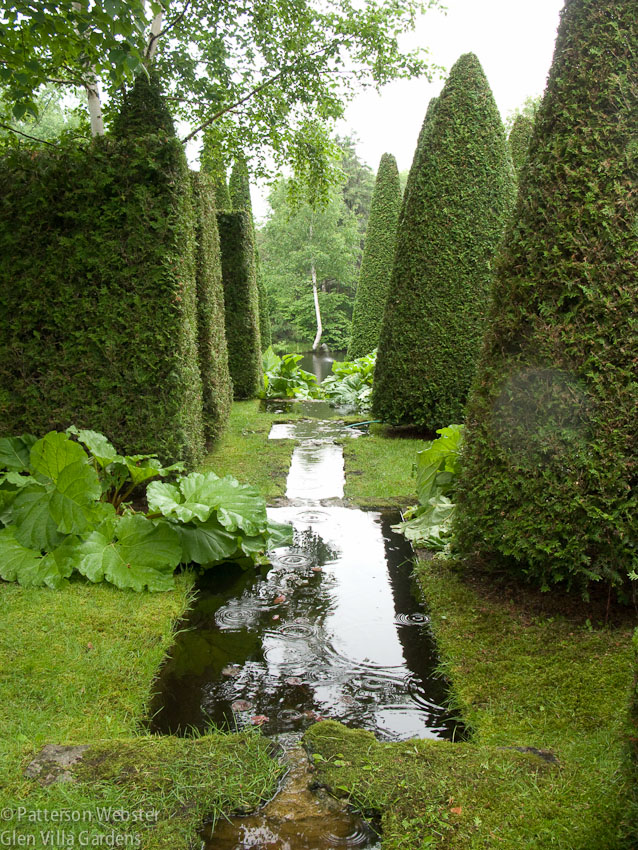
The rill at Les Quatre Vents echoes the shape of one at Shute House in Dorset. Does the vegetation close to the rill improve on Sir Geoffrey Jellicoe’s design?
The shape of this hillside water feature is so similar to a design by Sir Geoffrey Jellicoe at Shute House in Dorset that the source seems unmistakeable. This may not be as clear in the photos as it is in reality, since I took the photo of the Cabot garden from the top of the rill and the one at Shute House from mid-way down.
I don’t fault Mr Cabot for re-using the idea — Sir Geoffrey’s design has Moorish precedents that I’m sure he would acknowledge. I do question the plantings, though. At Shute House, the rill emerges from an exuberantly planted area; it make its way down the hill through a broad and open area of grass, making the shape of the rill stand out clearly. At Les Quatre Vents, while the large leaves edging the rill provide a loose contrast to the tidily trimmed evergreens, the plantings interfere with this clear view of the design. (I do, however, applaud the crooked white birch tree that draws the eye into the space beyond the end of the rill.)
At Kiftsgate Court in England, I saw another Jellicoe knock-off. The pool that replaced an old tennis court copies a part of Jellicoe’s design for the garden at Sutton Place in Surrey. The stepping stones that cross the moat there carry a symbolic message — they are the first steps in an allegorical journey through time. The steps at Kiftsgate lead to an island; the only way off is to retrace your steps. What was meaningful has become decorative.
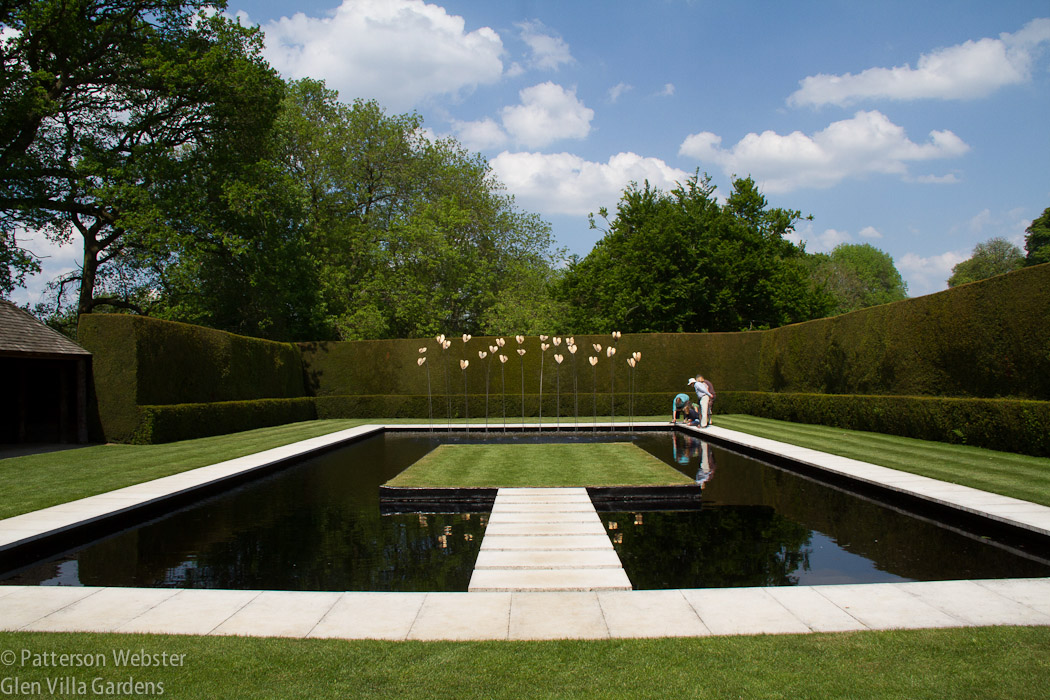
Steps lead onto the island in the tennis court pool at Kiftsgate Court in . Water spills off the philodendron leaves sculpted by Simon Allison.
Copying design ideas from other times and other places has a long and honourable history. Moorish gardens inspired Sir Geoffrey Jellicoe. Roman gardens and the statues they contained inspired Italian Renaissance designers. Indeed, it seems that in Renaissance times, copying was a competitive sport. Cardinals and popes competed to have the best this or the largest that. The water chains at Villa Lante …
were copied at Villa d’Este at Tivoli — one cardinal trying to out-do another.
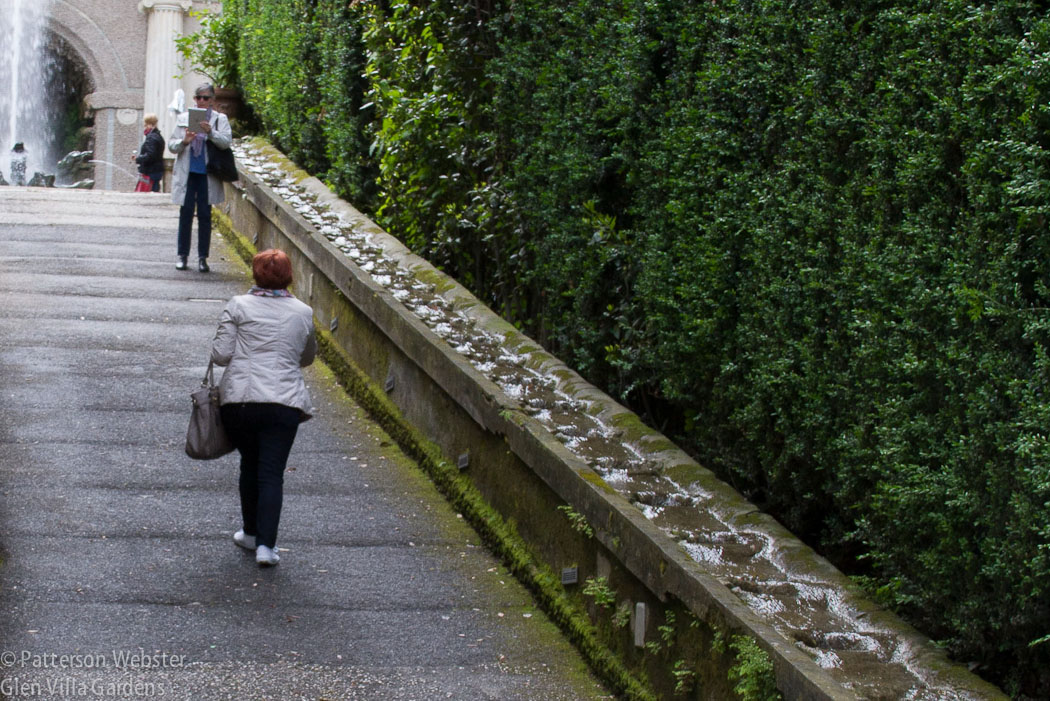
A water chain at Villa d”Este at Tivoli marked the original entrance to this garden which was intended to impress. It succeeded.
Visiting Vaux-le-Vicomte a few years ago, I had an ‘a-ha!’ moment when I climbed steps to a small side garden. Trees trimmed like stilts immediately made me think of Lawrence Johnson’s Stilt Garden at Hidcote.
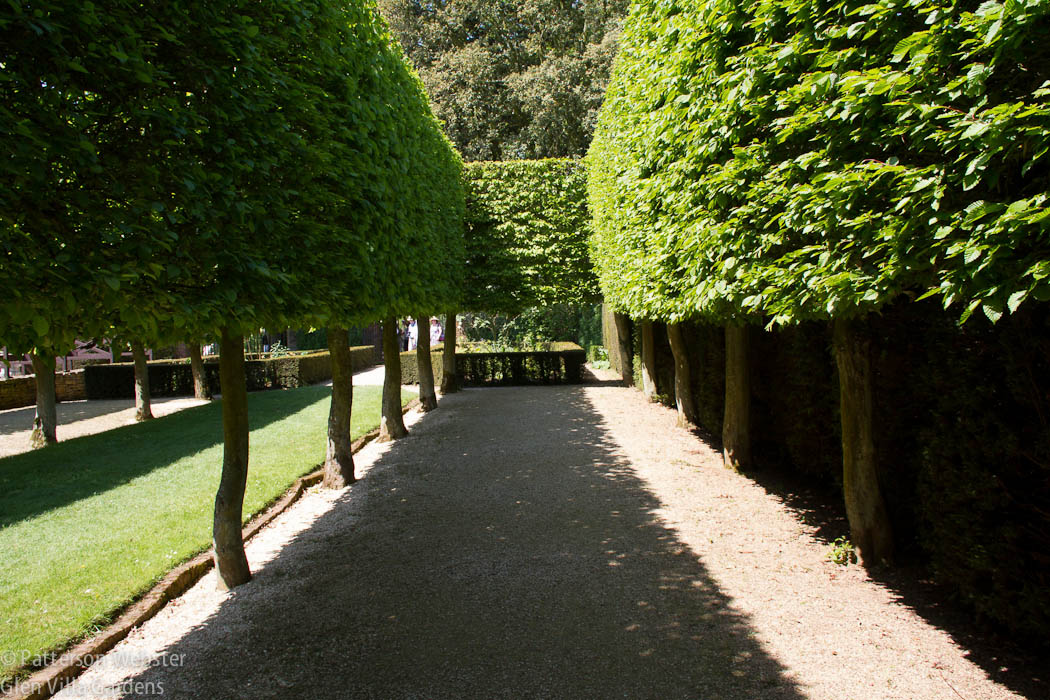
I don’t like the strong shadows in this photo but that was how this part of garden at Hidcote looked the day I was there. And why should I complain about sunshine in England?
Noting how the water chains at Villa Lante and Villa d’Este mimic one another made me wonder if their curving edges inspired the canal at Brian’s Ground in Herefordshire.
Copying a design does not necessarily entail copying the idea behind it. At Sutton Place the steps began a voyage of the mind. At Kiftsgate, they appear merely decorative. Curving edges are an essential part of Renaissance water chains, wavy edges at Brian’s Ground are not.
Inspiration from the past necessarily acquires different meanings in different times. The warning bells ring when a garden designer copies his or her own work. While she may be building on past experience, repetition becomes far too easy. Static ideas lose their impact and meaning.

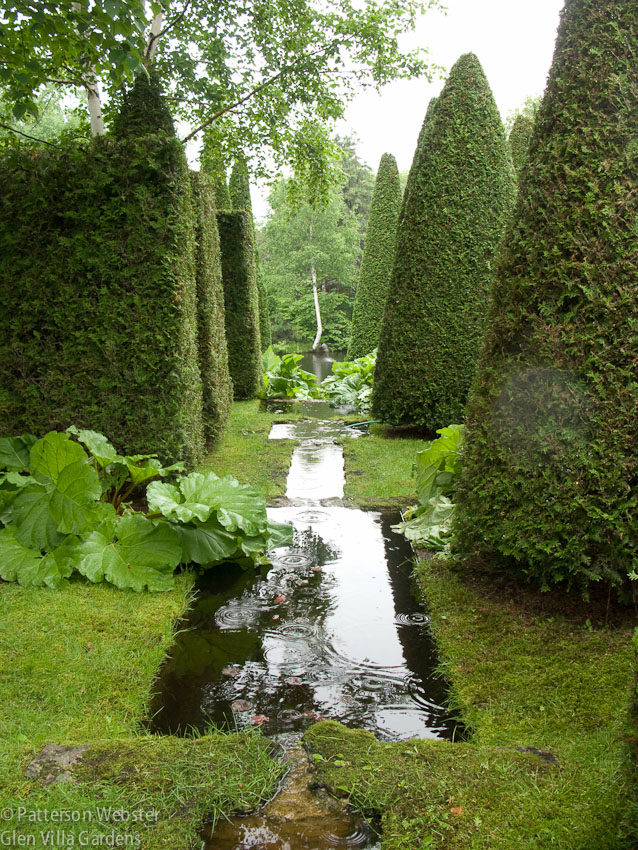

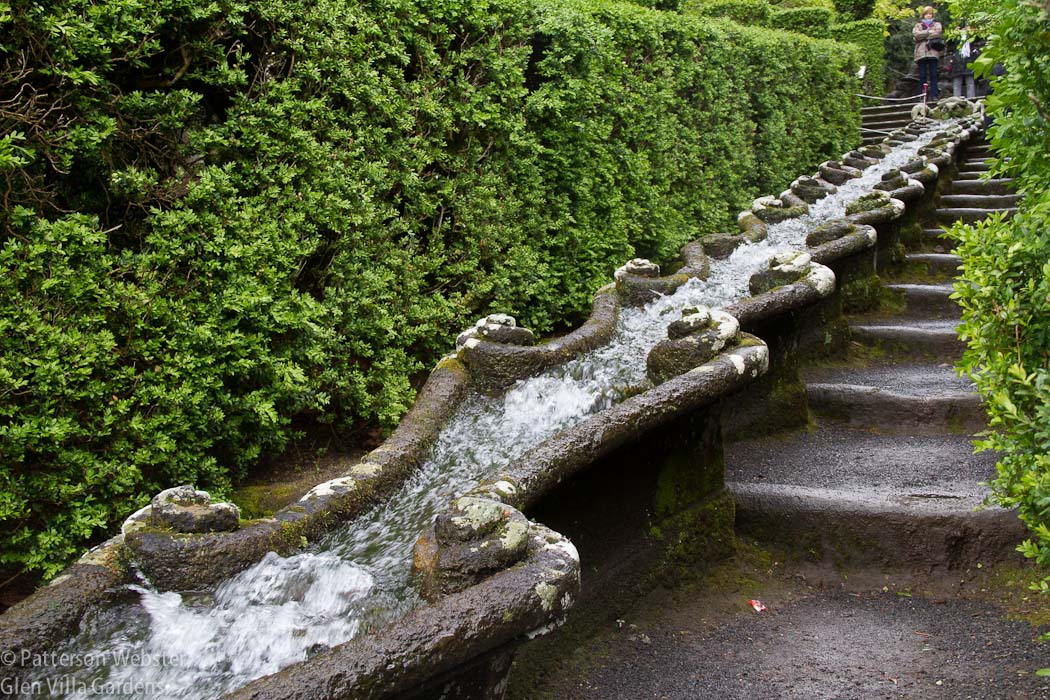
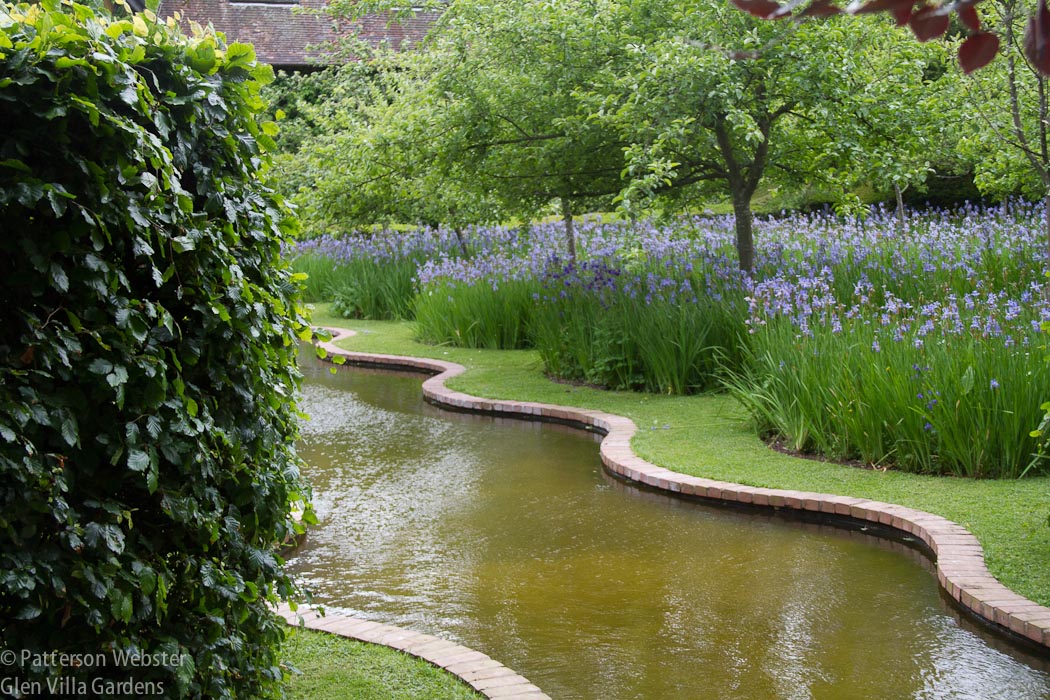





Pat, a very enjoyable post. Another in the list of imitations–Harold Peto’s water garden (and rill) at Buscot Park. Which came first, Shute House or Buscot Park? I don’t know.
I haven’t been to Buscot Park, James, but now that you mention it, I remember seeing photos of the rill there. I haven’t looked up the dates but almost certainly Peto’s water garden came first.
Hi Pat, I visited Les Quatre Vents for the first time last summer and came to the same conclusion. I also thought that the woodland garden was perhaps one of the most original of Mr. Cabot’s designs, it seemed the most sympathetic to that part of the landscape and that part of Quebec. The tour quide described the Pigeonnier garden as being French in influence, but I recognized Bodnant right away. I am a Welshman after all!
I think Mr Cabot’s success came in the way he absorbed influences and laid them out so baldly, in such a grand manner. The bands of planting in the woodland are wonderful as well as being the most original, I agree. I also like his double mirrored reflections in the hornbeam edged allée. I’ve never seen this done elsewhere. Have you? If I can find an appropriate place, I want to copy that idea myself. And of course you recognized Bodnant!
Fun post! While not an exact copy, Rosemary Verey’s potager was inspired by the one at Villandry, which was inspired by a 15th century style book.
I didn’t know that Verey got her inspiration from Villandry, but I’m not at all surprised — Villandry is worth copying. Like Cabot, Verey was a wonderful one for picking up and using others’ ideas. Cabot was straight-forward about his inspirations; I don’t know if Verey was. Do you?
I must give credit to Piet Oudolf for the Hedge Garden reflected in our Reflecting Pool at Veddw. (http://veddw.com/south-garden-pool-hedges/) One of my great pleasures was being able to thank him in situ when he visited us.
Oh, that is a FABULOUS story. I can’t imagine how gratifying it must have been. And that reminds me of another copy, the hedges at le jardin Plume in Normandy. Jacques Wirtz must figure in there along with Oudolf.
It was gratifying and his response to the garden was too. And I’m sure you’re right about Jardin Plume. I was so disappointed by the Wirtz hedges at Alnwick though.
O – and I’ve often thought in relation to my friends and our shared design elements that those designs create a map of friendships round the world…
A map of friendships round the world: that is such a nice way of thinking about mutual influences. Like you shire map that remembers the way things were.
Call it copying…..I call it flavors of one’s travels!
It is unusual to be accused of copying oneself ! The photo and design attributed to the Cultural Landscapes Foundation are in fact my own design and not that of Charles Jencks who, as far as I am aware, has not designed any similar stone balls. Correction please!
The Cultural Landscape Foundation has not responded to my enquiry for supporting documentation and I have not been able to find the original reference that I saw on line. Consequently I have removed the photos and text referring to Througham Court and The Garden of Cosmic Speculation. My apologies for this quite unintended error.
So, an age old question of where copying ends and imitation begins. I visit gardens the world over not only for pleasure but for inspiration. As Oscar Wilde famously said “Imitation is the highest form of flattery”.
I agree, Amy. It’s a fine line between copying and imitation, and one that different cultures see differently. In Chinese art, copying the works of past masters is an honourable thing to do, perhaps even more highly regarded than creating a design or painting of one’s own.I’ve imitated features seen in gardens from many different places, sometimes more successfully than others. The successful ones capture the spirit more than the form of the original.